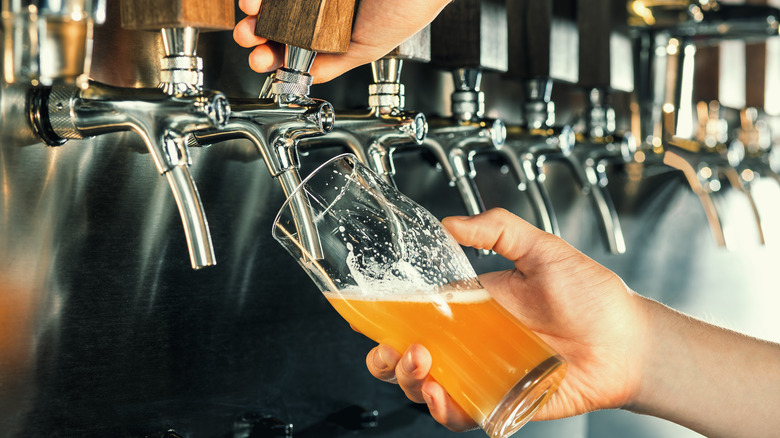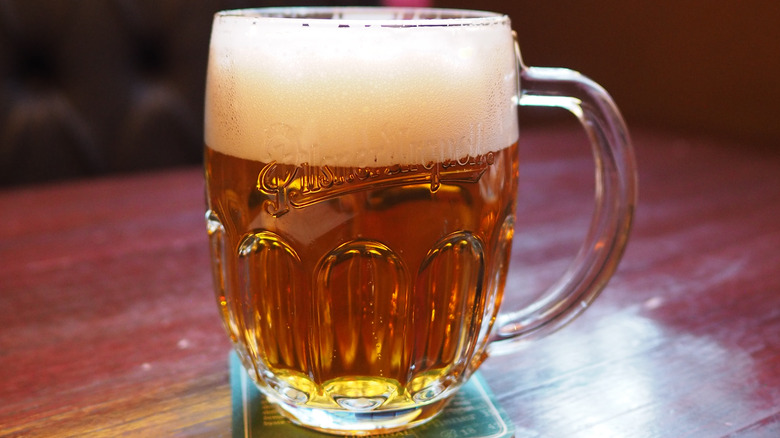Pilsner Vs Lager: What's The Difference?
Obviously, there are many different types of beer to choose between when the urge for a frosty brew hits. However, when faced with a list of beers at a bar, you may have trouble remembering which is which. You may, for example, easily recognize that a stout and a hard cider offer very different experiences, or that a wheat beer is different from a sour, but what about when it comes to more similar varieties?
If a lager and a pilsner prove more difficult to separate in your mind, you're not alone. That is because lager is a fairly broad category, encompassing multiple beers. Adding to your possible confusion could be that fact that, according to Homebrew Academy, there are two types of lagers, light and dark, meaning not all lagers look a like. A pilsner is one of those lager beers, though the two terms are not interchangeable. So, to recap, a pilsner is a type of pale lager, which shares characteristics with other pale lagers. Pale lagers also share characteristics with dark lagers, though not as many.
First, what is a lager?
Homebrew Academy describes all lagers as typically "clean" beers with a strong scent. Pale lagers are more yellow in color, while dark lagers will range from a reddish to brown.
Lager (which Eater explains comes from the German word lagern, meaning "to lie") is made with bottom-fermenting yeasts that need to be kept in cooler temperatures for a longer period of time do their magic when compared to top-fermenting yeasts. VinePair goes into greater detail about what bottom-fermenting means, but the name essentially says it all. The yeast ferments from the bottom of the wort instead of the top. One interesting fact about bottom-fermenting yeast is that it is a cross between Saccharomyces cerevisiae (a top fermenting yeast used in ales) and Saccharomyces eubayanus, which is a yeast believed to have originated in Patagonia.
Bottom-fermenting gives lagers that crisp, thirst-quenching quality we all know and love.
So, what makes pilsner special?
Pilsner is so called because it was first made in the Bohemian city of Plzen, which today is part of the Czech Republic. Originally, The Spruce Eats writes, Plzen produced ales. However, the town began to have an issue with its ales spoiling. In 1838, the ale spoiled one too many times, and the brewers of Plzen — tired of seeing the booze they made go to waste — invited Bavarian brewer Josef Groll to teach them a new method of brewing.
Groll taught them to make lager, and while doing so, local Saaz hops were introduced into the process. This hop is what lends pilsners their slightly spiced note, as described by JustBeer. Essentially, a pilsner is a lager that uses a special Czech hop. Other types of pilsners include the American and German varieties, which VinePair shares vary slightly to better suit their country of origin.
Lager and pilsner beers to try
Looking to taste test some lagers and pilsners? You're in luck, as Wine Enthusiast suggests that lager is the most popular variety of beer worldwide, meaning you probably won't have a problem finding one at a store near you.
Beers such as American Budweiser, Coors Light, and Corona are all considered lagers, while the outlet lists Pilsner Urquell as the most ubiquitous Czech pilsner; but you don't have to stick to the big brands. Many local craft brewers also have lagers and pilsners available, so be sure to give them a look. Craft Beer & Brewing's list of top ranked pilsners include options from smaller companies like Two Roads, Elsewhere, and The Austin Garden Brewing Co., alongside more widely available brands like Bitbuger. As far as other types of lagers are concerned, Men's Journal recommends craft breweries like Cape May Brewing Co., Brooklyn Brewery, and Saint Archer as having excellent options in a variety of lager styles.



